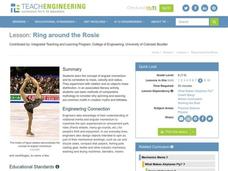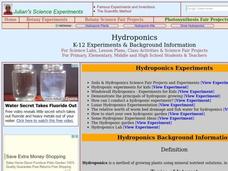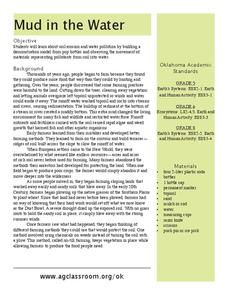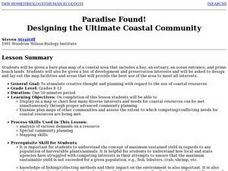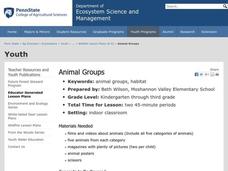Curated OER
Creating a Classification System
Students create classification system for Arctic-dwelling animals, the Arctic hare in particular.
Curated OER
Something Fishy - Bioaccumulation of Mercury
Young scholars explore the dangers of eating high levels of mercury and how small amounts of mercury in water accumulate in greater quantities in organisms higher in the food chain. They list the health of effects of high levels of...
Michigan Sea Grant
Wetlands
Wetlands may not sound particularly ornate, but they are as important as any habitat! With a hands-on activity, young scientists build a wetland model and observe its many functions in action. They discover the importance of wetlands to...
Curated OER
How about a Little Give and Take?
Students design a closed system to test the relationships between plants and animals. They monitor abiotic fluctuations within this living system by using a chemical test kit. They observe how living organisms respond to fluctuations in...
Curated OER
Ring Around the Rosie
Students examine the concept of angular momentum and its correlation to mass, velocity, and radius. They listen to a teacher-led lecture, conduct an experiment with rotational inertia, angular momentum, and rotation speed by making...
Curated OER
A Fishy Problem
Young scholars survey the problems involved in finding a solution to a practical problem using a mathematical process. Students make sensible estimates and check the reasonableness of their answers. Young scholars report the results of...
Curated OER
Marine Biology Field Trips
Students visit a Marine Biology study area 2-3 times and write a report after the last visit. They participate in the Marine Biology field trips working with lab partners. They complete data sheets to write their primitive environmental...
Curated OER
Cloze Instruction And Herringbone Technique
Students sort out important information and create a visual framework for reviewing in the future. They organize a large quantity of information thus helping with learning and remembering details, cause and effect, comparison and...
Curated OER
Migrate, Adapt, or Hibernate
For this migration and hibernation worksheet, students read a 2 page informational excerpt about animals who adapt to changing seasons by migrating or hibernating. They then use the information they learned to answer the 15 questions on...
Curated OER
Examining the Stages of Ecological Succession
In this ecological succession worksheet, students answer questions about the process of succession in four ponds given diagrams and descriptions.
Curated OER
Properties of Matter
Students investigate the properties of matter. In this properties of matter lesson, students observe containers of different metals and discuss their properties including density. Students find the density of an unknown metal and of...
Curated OER
Biology In Elementary Schools
Students classify animals into six major animal groups and describe the characteristics of the animals found within each group. In this living and non-living animals lesson, students observe a variety of animals, both living and...
Curated OER
Hydroponics
Students examine how to grow plants using a hydroponic system. In this hydroponics lesson students identify the advantages and disadvantages of growing plants hydrologically.
Curated OER
Build Your Own Submarine
Students construct their own submarine following a certain procedure. For this physics lesson, students calculate the density of objects using a mathematical formula. They explain why some object floats in water while some do not.
Curated OER
Identifying Pennsylvania Watersheds
Ninth graders study and identify the six major drainage systems in Pennsylvania. In this watershed lesson students read an article, complete an activity and take a quiz on what they learned.
Curated OER
Oil Spill
In this reading comprehension learning exercise, students read a 7-paragraph article about the 2010 Gulf Oil Spill and respond to 5 short answer questions. Vocabulary words and definitions are included.
Curated OER
Mud in the Water
Sixth graders investigate erosion. In this erosion activity, 6th graders explore how farming changes the environment. Students construct an erosion model and research ways to protect the soil from excess mud generated by farming.
Curated OER
Introduction to Dissolved Oxygen and Demonstration of a Simple Test Procedure
Young scholars explain the importance of dissolved oxygen in water ecosystems. They describe the aquatic oxygen cycle and the effect of water pollution on oxygen. They make observations, collect data and draw a conclusion.
Curated OER
Pet Shop Decision
Students are given the "Pet Store Decisions" task sheet and a rubric that goes with it. Students discuss the task and make a plan for using the rubric sheet to complete the task. Students formulate questions, studies and data collection...
Curated OER
Creating a Coastal Area
Students design and lay out a map of a coastal area that includes a bay, an estuary, an ocean entrance, and prime beach lands. They write a plan outlining solutions to the economic problems of their community and present their map and...
Curated OER
Animal Groups
Students explore animal groups. In this animal science lesson, students use pictures from magazines and classify the animals into five categories. Students share why they categorized the animals the way they did.
Curated OER
Korean History Through Journaling
Students explore Korea and details about the Choson Kingdom. In this Korea lesson, students examine the geographical location of Korea. Students also take notes on a lecture about the Choson Kingdom and relations between Japan and Korea....
Curated OER
Animals attributes
First graders analyze different animals in fiction and nonfiction stories. For this animal lesson, 1st graders choose an animal and read a fiction story with that animal as a character. They describe how the animal acted in the story and...
Curated OER
Making a Fossilized Egg
Students explore fossils by participating in an in class experiment. In this archaeology lesson, students utilize dough and classroom objects to create fossil imprints after hiding the toy/fossil in the dough egg. Students categorize the...






